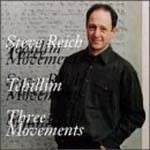2.2picc.2.corA.3.3(III=dbn).dbn-4.3.3.1-perc:2marimbas/2vib/
BD-2pft(4 hands)-strings(db=elec.bass)*
Strings: left:6.6.4.4.4;right:6.6.4.4.4
If required for balance, 1st vln section right may be expanded to
8 players.
*reh. 44 to the end, the Contrabass part is to be played by 2 electric basses, 1 on a part. All other acoustic basses are tacet until end of piece.
This work requires additional technological components and/or amplification.
Abbreviations (PDF)
Boosey & Hawkes (Hendon Music)
The arrangement of the orchestra on stage is somewhat unusual and follows the layout of the orchestra for my previous work for orchestra and chorus, The Desert Music (1984). The mallet percussion (two marimbas and two vibraphones) as well as the two pianos are placed directly in front of the conductor. This is one because these instruments play constantly and supply the ongoing rhythm of the piece. If they were put in their usual position in the rear of the orchestra time delay between what the rest of the orchestra heard from them and what they saw of the conductor’s beat would not be in sync. Placing them directly in front of the conductor enables the full orchestra to see and hear one unified rhythm direction.
The string orchestra is completely divided into two equal string orchestras right and left, somewhat as in Bartok’s Music for Strings, Percussion and Celesta. The purpose here is to clarify the counterpoint between the two string orchestras; each group can bow together, and the listener can hear each group more clearly. In the opening pulse section of the piece each gradual change in harmony is alternated in a gently overlapping way between the two string groups. This slow change from chord to chord may suggest the changing light as clouds move slowly across the sky, or, in musical terms, it may recall the middle piece in Schoenberg’s Five Pieces for Orchestra, "Farben," or "Summer Morning by a Lake."
The opening harmonies are mostly altered dominant chords with their roots moving in minor thirds – E, D-flat, B-flat, G, and back to E – outlining the ambiguous diminished seventh chord. This ambiguous harmonic movement is used throughout the piece until, at the end, it finally resolves to A minor.
The three movements – fast, slow, fast – are played without pause. The tempo of the slow middle movement is exactly half that of the first movement, and the final movement resumes the tempo of the opening one.
After the opening pulse section of the first movement, the remainder of that movement gradually moves from pulse to melodic patterns in such a way that it may be difficult to say when the pulses end and when the melodic patterns begin. The second movement comes directly from my earlier Sextet (1985). In the fourth movement of that piece I used synthesizers for slow melodic patterns in two-part canon that seemed to suggest oboes and clarinets. Here one can hear those woodwinds along with quiet violins playing this material, supported by two vibraphones, bass drum and low strings and winds. Eventually the woodwinds and violins fade away and the accompaniment of vibraphones, bass drum and low strings and winds becomes the new melodic focus.
The final fast movement draws upon both my Sextet and New York Counterpoint (1985). After the upper voices of the orchestra have built up a two-part canonic texture the lower voices begin accenting this material so that it is perceived first as three groups of four beats each and then as four groups of three beats each. This kind of rhythmic ambiguity has been a mark of my music. The piece is concluded with a kind of mensuration canon – or canon in which the subject appears simultaneously in two or more speeds – the subject being a rhythmic pattern found in the high bell part of West African music. This canon in the entire orchestra moves upward, leaving the bass behind until it reaches its cadence on a high A minor.
Steve Reich
Reproduction Rights
This programme note can be reproduced free of charge in concert programmes with a credit to the composer

London Symphony Orchestra / Michael Tilson Thomas
Nonesuch 79295

